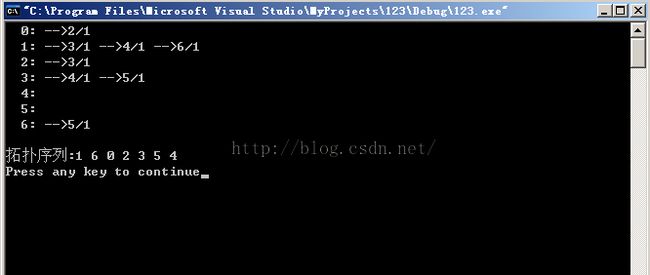项目5 -- 拓扑排序算法的实现
/*
* Copyright (c) 2015, 烟台大学计算机与控制工程学院
* All rights reserved.
* 文件名称:main.cpp,graph.h,graph.cpp
* 作者:张志康
* 完成日期:2015年11月23日
* 版本号:vc++6.0
*
* 问题描述:拓扑排序算法的实现
* 输入描述:
* 程序输出:
*/
代码:
#include <stdio.h>
#include <malloc.h>
#include "graph.h"
void TopSort(ALGraph *G)
{
int i,j;
int St[MAXV],top=-1; //栈St的指针为top
ArcNode *p;
for (i=0; i<G->n; i++) //入度置初值0
G->adjlist[i].count=0;
for (i=0; i<G->n; i++) //求所有顶点的入度
{
p=G->adjlist[i].firstarc;
while (p!=NULL)
{
G->adjlist[p->adjvex].count++;
p=p->nextarc;
}
}
for (i=0; i<G->n; i++)
if (G->adjlist[i].count==0) //入度为0的顶点进栈
{
top++;
St[top]=i;
}
while (top>-1) //栈不为空时循环
{
i=St[top];
top--; //出栈
printf("%d ",i); //输出顶点
p=G->adjlist[i].firstarc; //找第一个相邻顶点
while (p!=NULL)
{
j=p->adjvex;
G->adjlist[j].count--;
if (G->adjlist[j].count==0)//入度为0的相邻顶点进栈
{
top++;
St[top]=j;
}
p=p->nextarc; //找下一个相邻顶点
}
}
}
int main()
{
ALGraph *G;
int A[7][7]=
{
{0,0,1,0,0,0,0},
{0,0,0,1,1,0,1},
{0,0,0,1,0,0,0},
{0,0,0,0,1,1,0},
{0,0,0,0,0,0,0},
{0,0,0,0,0,0,0},
{0,0,0,0,0,1,0}
};
ArrayToList(A[0], 7, G);
DispAdj(G);
printf("\n");
printf("拓扑序列:");
TopSort(G);
printf("\n");
return 0;
}
运行结果:
学习总结:

